1999 HONDA ODYSSEY steering
[x] Cancel search: steeringPage 1 of 343

1999 Odyssey Online Reference Owner's Manual
Use these links (and links throughout this manual) to navigate through\
this reference.
For a printed owner's manual, click on authorized manuals or go to www.h\
elminc.com.
Contents
Introduction ........................................................................\
................................................................. i
A Few Words About Safety........................................................................\
.........................................ii
Your Vehicle at a Glanc e........................................................................\
............................................ .2
Driver and Passenger Safety ........................................................................\
......................................5
Proper use and care of your vehicle's seat belts, and Supplemental Restr\
aint System.
Instruments and Control s........................................................................\
.........................................55
Instrume nt panel indicator and gauge, and how to use dashboard and steering colu\
mn controls.
Comfort and Convenience Features ........................................................................\
......................129
How to operate the climate control system, the audio system, and other c\
onvenience features.
Before Driving........................................................................\
..........................................................181
What gasoline to use, how to break -in your new vehicle, and how to load luggage and other cargo.
Driving ........................................................................\
......................................................................195
The proper way to start the engine, shift the transmission, and park, pl\
us towing a trailer.
Maintenance........................................................................\
.............................................................219
The Maintenance Schedule shows you when you need to take you r vehicle to the dealer.
Appearance Car e........................................................................\
..................................................... .277
Tips on cleaning and protecting your vehicle. Things to look for if your\
vehicle ever needs body repairs.
Taking Care of the Unexpecte d........................................................................\
..............................285
This section covers several problems motorists sometimes experience, an d how to handle them.
Technical Informatio n........................................................................\
.............................................313
ID numbers, dimensions, capacities, and technical information.
Warranty and Customer Relations (U.S. and Canad a
)...............................................................
.327
A summary of the warranties covering your new Acura, and how to contact \
us.
Authorized Manu als (U.S. only)........................................................................\
..............................333
How to order manuals and other technical literature.
Index........................................................................\
.............................................................................. I
Service Information Summary
A summary of information you need when you pull up to the fuel pump.
Owner's Identification Form
ProCarManuals.com
Page 5 of 343

Your Vehicle at a Glance
*
:
To use the horn, press the pad around the "H" logo.
TRACTION CONTROL SYSTEM
(P.207) HEADLIGHTS/
TURN SIGNALS
(P.66/68)
HAZARD WARNING
LIGHTS
(P.70)
DIGITAL CLOCK
(P.117)
REAR WINDOW
DEFOGGER(P.71)
LIGHT CONTROL
SWITCH (P.125)
WINDSHIELD
WIPERS/WASHERS
(P.68/70)
CRUISE
CONTROL
(P.73)
HORN*
STEERING WHEEL
ADJUSTMENT (P.72)
POWER SLIDING
DOOR SWITCHES(P.90)
MIRROR
CONTROLS (P.115)
REMOTE AUDIO
CONTROLS
(P.179)
CRUISE
CONTROL
(P.73)
ProCarManuals.comMain Menu s t
Page 6 of 343
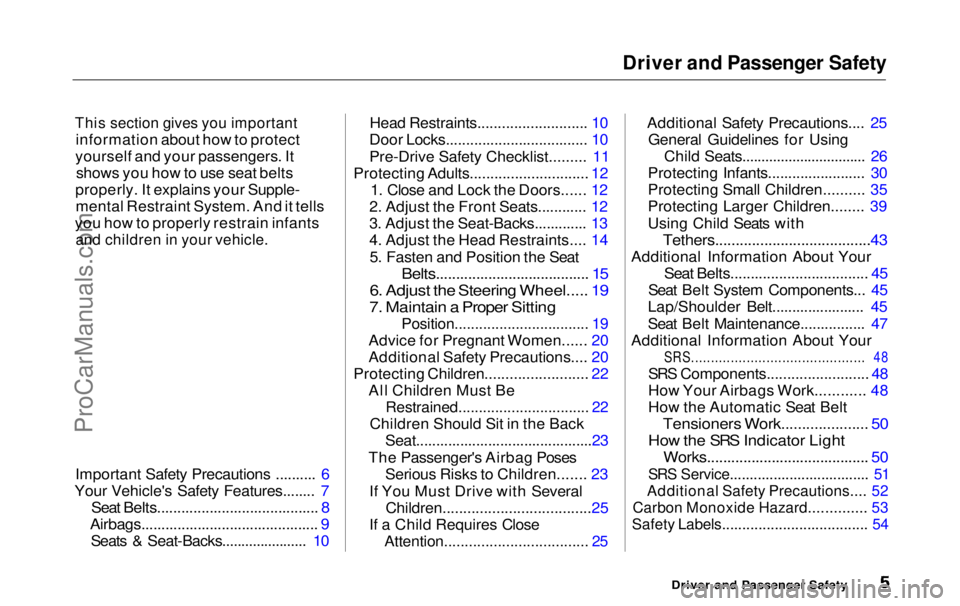
Driver and Passenger Safety
This section gives you important
information about how to protect
yourself and your passengers. It shows you how to use seat belts
properly. It explains your Supple- mental Restraint System. And it tells
you how to properly restrain infants
and children in your vehicle.
Important Safety Precautions .......... 6
Your Vehicle's Safety Features........ 7
Seat Belts........................................ 8
Airbags............................................ 9
Seats & Seat-Backs...................... 10 Head Restraints........................... 10
Door Locks................................... 10
Pre-Drive Safety Checklist......... 11
Protecting Adults............................. 12 1. Close and Lock the Doors...... 12
2. Adjust the Front Seats............ 12
3. Adjust the Seat-Backs............. 13
4. Adjust the Head Restraints.... 14
5. Fasten and Position the Seat
Belts...................................... 15
6. Adjust the Steering Wheel..... 19
7. Maintain a Proper Sitting
Position................................. 19
Advice for Pregnant Women...... 20
Additional Safety Precautions.... 20
Protecting Children......................... 22
All Children Must Be
Restrained................................ 22
Children Should Sit in the Back Seat............................................23
The Passenger's Airbag Poses Serious Risks to Children....... 23
If You Must Drive with Several Children....................................25
If a Child Requires Close
Attention................................... 25
Additional Safety Precautions.... 25
General Guidelines for Using Child Seats................................ 26
Protecting Infants........................ 30
Protecting Small Children.......... 35
Protecting Larger Children........ 39
Using Child Seats with
Tethers......................................43
Additional Information About Your
Seat Belts.................................. 45
Seat Belt System Components... 45
Lap/Shoulder Belt....................... 45
Seat Belt Maintenance................ 47
Additional Information About Your
SRS............................................ 48
SRS Components......................... 48
How Your Airbags Work............ 48
How the Automatic Seat Belt
Tensioners Work..................... 50
How the SRS Indicator Light
Works........................................ 50
SRS Service................................... 51
Additional Safety Precautions.... 52
Carbon Monoxide Hazard.............. 53
Safety Labels.................................... 54
Driver and Passenger SafetyProCarManuals.comMain Menu s t
Page 8 of 343
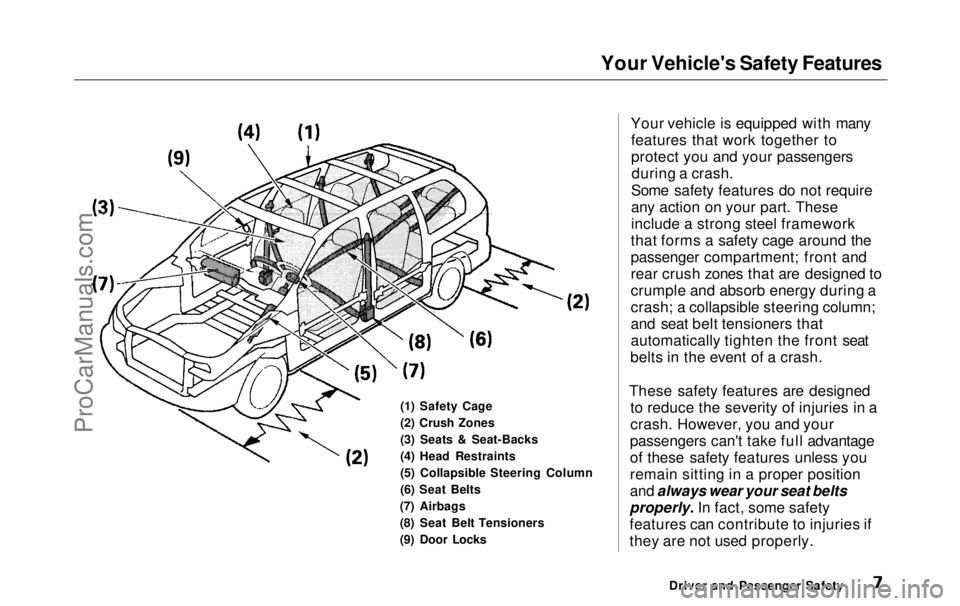
Your Vehicle's Safety Features
(1) Safety Cage
(2) Crush Zones
(3) Seats & Seat-Backs
(4) Head Restraints
(5) Collapsible Steering Column
(6) Seat Belts
(7) Airbags
(8) Seat Belt Tensioners
(9) Door Locks Your vehicle is equipped with many
features that work together to
protect you and your passengersduring a crash.
Some safety features do not require
any action on your part. These
include a strong steel framework
that forms a safety cage around the
passenger compartment; front and
rear crush zones that are designed to
crumple and absorb energy during a
crash; a collapsible steering column;
and seat belt tensioners that
automatically tighten the front seat
belts in the event of a crash.
These safety features are designed to reduce the severity of injuries in a
crash. However, you and your
passengers can't take full advantage
of these safety features unless you
remain sitting in a proper position
and always wear your seat belts
properly. In fact, some safety
features can contribute to injuries if
they are not used properly.
Driver and Passenger SafetyProCarManuals.comMain Menu Table of Contents s t
Page 10 of 343
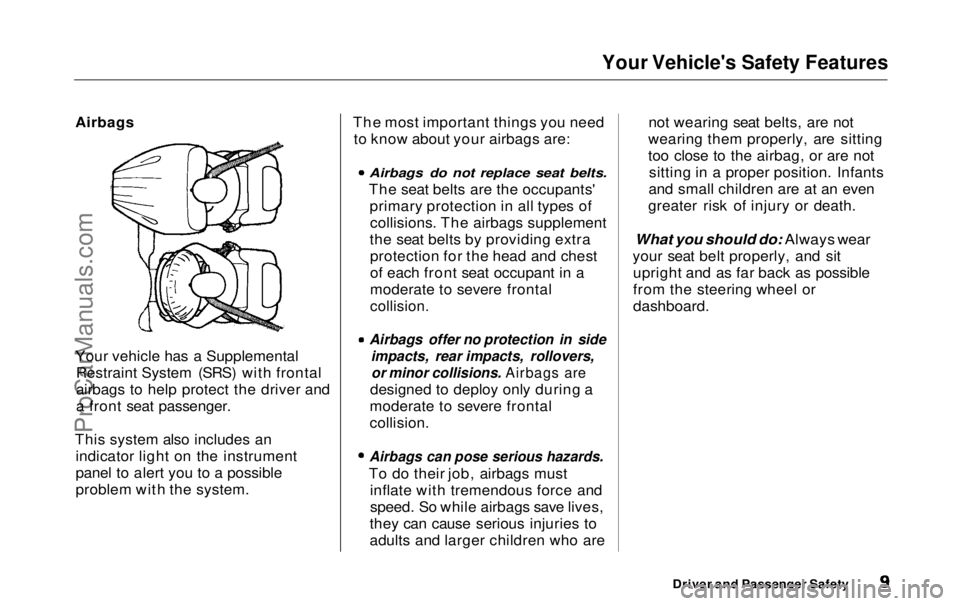
Your Vehicle's Safety Features
Airbags
Your vehicle has a Supplemental Restraint System (SRS) with frontal
airbags to help protect the driver and
a front seat passenger.
This system also includes an indicator light on the instrument
panel to alert you to a possible
problem with the system. The most important things you need
to know about your airbags are:
Airbags do not replace seat belts.
The seat belts are the occupants' primary protection in all types ofcollisions. The airbags supplement
the seat belts by providing extra protection for the head and chest
of each front seat occupant in a
moderate to severe frontal
collision.
Airbags offer no protection in side
impacts, rear impacts, rollovers,
or minor collisions. Airbags are
designed to deploy only during a
moderate to severe frontal
collision.
Airbags can pose serious hazards.
To do their job, airbags must inflate with tremendous force and
speed. So while airbags save lives,
they can cause serious injuries to
adults and larger children who are not wearing seat belts, are not
wearing them properly, are sitting
too close to the airbag, or are not sitting in a proper position. Infants
and small children are at an even
greater risk of injury or death.
What you should do: Always wear
your seat belt properly, and sit upright and as far back as possible
from the steering wheel or
dashboard.
Driver and Passenger SafetyProCarManuals.comMain Menu Table of Contents s t
Page 11 of 343
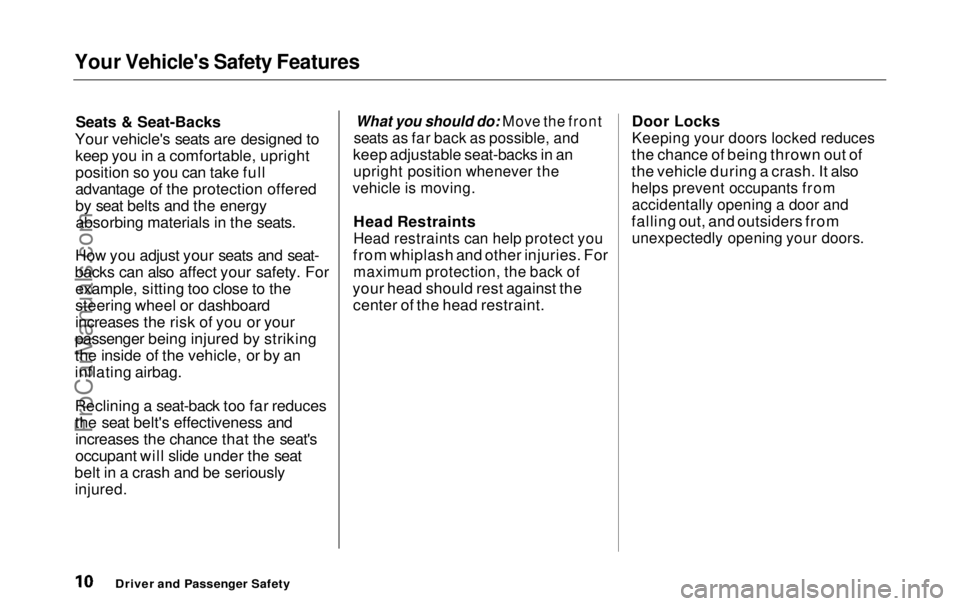
Your Vehicle's Safety Features
Seats & Seat-Backs
Your vehicle's seats are designed to keep you in a comfortable, upright
position so you can take full
advantage of the protection offered
by seat belts and the energyabsorbing materials in the seats.
How you adjust your seats and seat-
backs can also affect your safety. For example, sitting too close to the
steering wheel or dashboard
increases the risk of you or your
passenger being injured by striking
the inside of the vehicle, or by an
inflating airbag.
Reclining a seat-back too far reduces
the seat belt's effectiveness and increases the chance that the seat's
occupant will slide under the seat
belt in a crash and be seriously
injured.
What you should do: Move the front
seats as far back as possible, and
keep adjustable seat-backs in an
upright position whenever the
vehicle is moving.
Head Restraints
Head restraints can help protect you
from whiplash and other injuries. For
maximum protection, the back of
your head should rest against the center of the head restraint. Door Locks
Keeping your doors locked reduces
the chance of being thrown out of
the vehicle during a crash. It also
helps prevent occupants from
accidentally opening a door and
falling out, and outsiders from
unexpectedly opening your doors.
Driver and Passenger SafetyProCarManuals.comMain Menu Table of Contents s t
Page 12 of 343
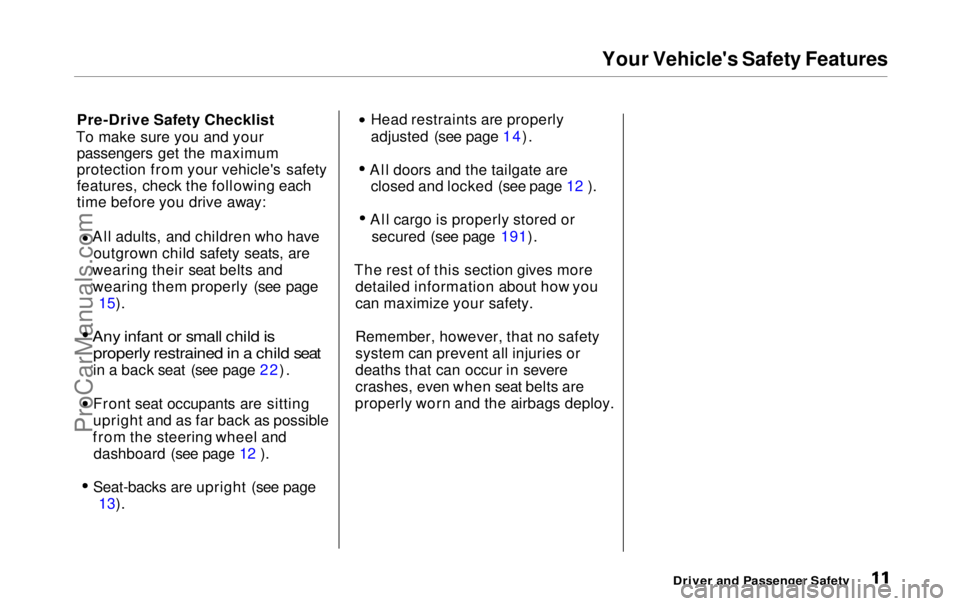
Your Vehicle's Safety Features
Pre-Drive Safety Checklist
To make sure you and your passengers get the maximum
protection from your vehicle's safety
features, check the following each
time before you drive away: All adults, and children who have
outgrown child safety seats, are
wearing their seat belts and wearing them properly (see page 15).
Any infant or small child is
properly restrained in a child seat
in a back seat (see page 22). Front seat occupants are sitting
upright and as far back as possible
from the steering wheel and dashboard (see page 12 ). Seat-backs are upright (see page
13). Head restraints are properly
adjusted (see page 14).
All doors and the tailgate are
closed and locked (see page 12 ). All cargo is properly stored or
secured (see page 191).
The rest of this section gives more detailed information about how you
can maximize your safety.
Remember, however, that no safety
system can prevent all injuries or
deaths that can occur in severe
crashes, even when seat belts are
properly worn and the airbags deploy.
Driver and Passenger SafetyProCarManuals.comMain Menu Table of Contents s t
Page 13 of 343
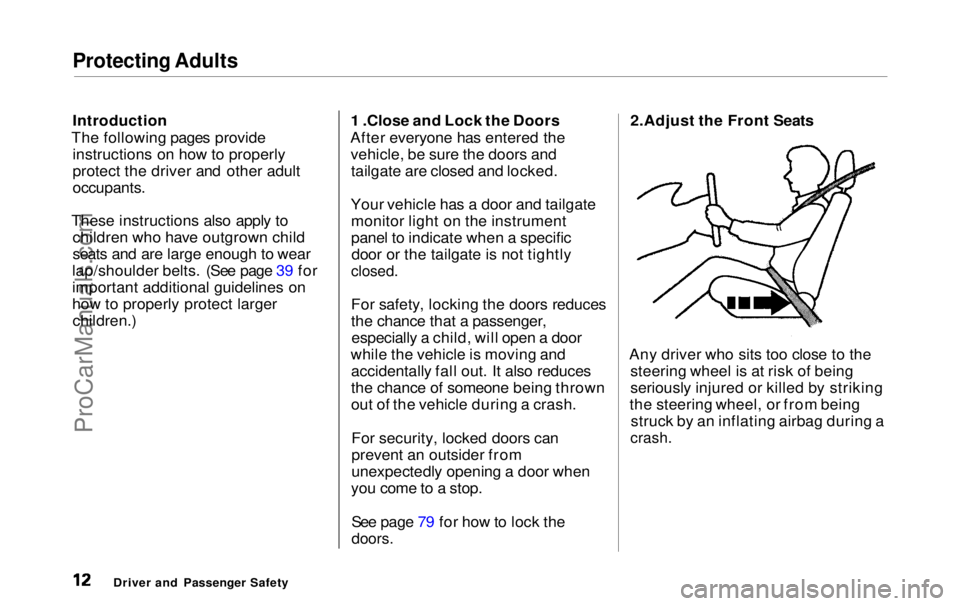
Protecting Adults
Introduction
The following pages provide instructions on how to properly
protect the driver and other adult
occupants.
These instructions also apply to children who have outgrown child
seats and are large enough to wear
lap/shoulder belts. (See page 39 for
important additional guidelines on
how to properly protect larger children.) 1 .Close and Lock the Doors
After everyone has entered the vehicle, be sure the doors andtailgate are closed and locked.
Your vehicle has a door and tailgate monitor light on the instrument
panel to indicate when a specificdoor or the tailgate is not tightly
closed.
For safety, locking the doors reduces
the chance that a passenger, especially a child, will open a door
while the vehicle is moving and accidentally fall out. It also reduces
the chance of someone being thrown
out of the vehicle during a crash.
For security, locked doors can
prevent an outsider from
unexpectedly opening a door when
you come to a stop.
See page 79 for how to lock the
doors.
2.Adjust the Front Seats
Any driver who sits too close to the steering wheel is at risk of being
seriously injured or killed by striking
the steering wheel, or from being struck by an inflating airbag during a
crash.
Driver and Passenger SafetyProCarManuals.comMain Menu Table of Contents s t